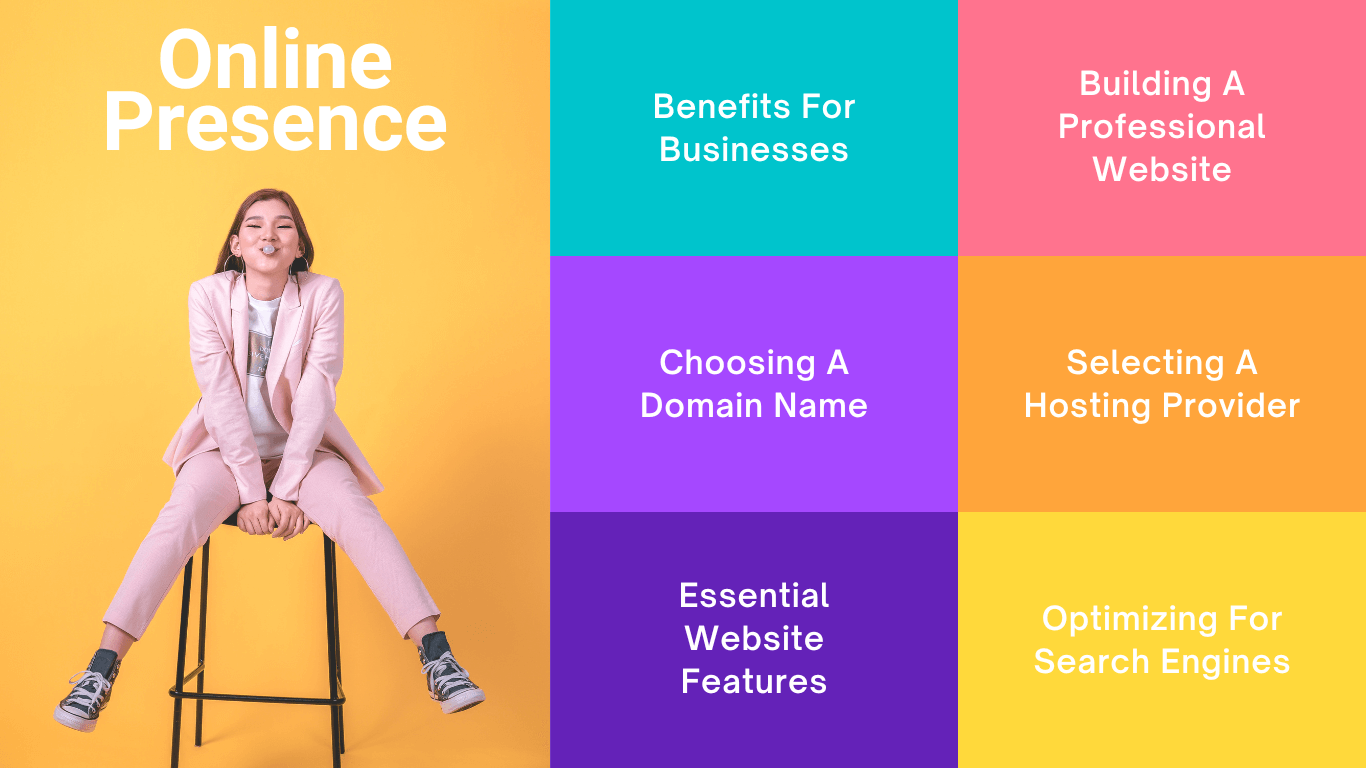To create an online presence for your business, establish a professional website and utilize social media platforms. These steps help attract and engage potential customers.
In today’s digital age, an online presence is crucial for any business aiming for growth and success. A professional website acts as your digital storefront, offering information about your products or services. Social media platforms like Facebook, Twitter, and Instagram enable you to connect with a wider audience, increasing brand visibility.
Regularly updating content and interacting with followers builds trust and credibility. Investing in search engine optimization (SEO) ensures your business ranks higher in search results. Email marketing campaigns can also drive traffic to your site, converting visitors into customers. Embrace these strategies to effectively establish your business online.
Introduction To Online Presence
Creating an online presence for your business is essential in today’s digital age. With more people spending time online, your business needs a strong digital footprint. But where do you start? This section will introduce you to the concept of online presence and its significance for your business.
Importance Of Online Presence
Your online presence is crucial for reaching a wider audience. It allows potential customers to find you easily. Here are some key points highlighting the importance of having an online presence:
- Visibility: A strong online presence makes your business visible to a global audience.
- Credibility: An online presence establishes your business as credible and trustworthy.
- Accessibility: Customers can access your products or services 24/7.
Consider the following table to understand the importance:
| Factor | Impact |
|---|---|
| Search Engine Rankings | Higher visibility in search results |
| Customer Engagement | Better interaction with customers |
| Brand Awareness | Increased brand recognition |
Benefits For Businesses
Having a strong online presence offers numerous benefits for your business. Here are some of the key advantages:
- Increased Traffic: Attract more visitors to your website.
- Lead Generation: Convert visitors into potential customers.
- Customer Insights: Gain valuable insights through analytics.
In summary, an online presence is not just about being visible. It is about being accessible, credible, and engaging. Start building your online presence today to reap these benefits.

Credit: www.youtube.com
Building A Professional Website
Creating a professional website is crucial for establishing your business online. Your website serves as the digital face of your brand. It should be attractive, functional, and user-friendly. Here’s how you can build a professional website step by step.
Choosing A Domain Name
Your domain name is the web address where customers find you. Choose a domain that is short, memorable, and relevant to your business. Ideally, it should include keywords related to your business. Use tools like Domainr or LeanDomainSearch to check availability. Avoid numbers and hyphens; they can confuse users.
Selecting A Hosting Provider
A reliable hosting provider ensures your website loads quickly and remains accessible. Look for providers with high uptime guarantees and excellent customer support. Popular hosting providers include:
Consider the type of hosting you need—shared, VPS, or dedicated. Shared hosting is cost-effective for small businesses. VPS and dedicated hosting offer more resources and control for larger websites.
Essential Website Features
Your website should include key features that enhance user experience. Here are some essential elements:
| Feature | Description |
|---|---|
| Responsive Design | Ensure your site looks good on all devices. |
| Clear Navigation | Users should easily find information. |
| Contact Information | Include phone number, email, and address. |
| Call-to-Actions (CTAs) | Guide users to take specific actions. |
| About Us Page | Share your business story and values. |
Incorporate these features to create a professional and user-friendly website. This will help you attract and retain visitors, ultimately boosting your online presence.
Optimizing For Search Engines
Optimizing for search engines is essential for creating an online presence. This process ensures your business is visible on search engines. It involves strategies to improve search engine rankings and attract more organic traffic. Let’s explore the key components of search engine optimization (SEO).
Keyword Research
Keyword research is the foundation of SEO. It involves identifying terms your target audience searches for. Use tools like Google Keyword Planner or SEMrush. Focus on keywords with high search volume and low competition.
Consider long-tail keywords. These phrases usually contain three or more words. They are specific and have lower competition. Long-tail keywords help attract more targeted traffic.
| Tool | Purpose |
|---|---|
| Google Keyword Planner | Find search volume and competition |
| SEMrush | Analyze competitors and keyword difficulty |
On-page Seo Techniques
On-page SEO involves optimizing individual web pages. Focus on both content and HTML source code. Key techniques include:
- Title Tags: Use primary keywords in your title tags.
- Meta Descriptions: Write compelling meta descriptions with keywords.
- Header Tags: Use H1 tags for titles and H2-H6 for subheadings.
- Alt Text: Add descriptive alt text to images.
- Internal Links: Link to other pages within your website.
- Content Quality: Write unique, valuable content for your audience.
Off-page Seo Strategies
Off-page SEO focuses on activities outside your website. These activities improve your site’s authority and ranking. Key strategies include:
- Backlinks: Earn backlinks from reputable websites.
- Social Media: Share content on social media platforms.
- Guest Blogging: Write guest posts on relevant blogs.
- Influencer Outreach: Collaborate with influencers in your industry.
- Online Directories: Submit your site to online directories.
Quality backlinks are crucial for off-page SEO. They signal trust and authority to search engines. Focus on getting links from high-authority sites in your niche.

Credit: www.strikingly.com
Leveraging Social Media Platforms
Social media is a powerful tool for businesses. It helps connect with customers, build brand awareness, and drive sales. Understanding how to leverage social media platforms can significantly boost your online presence.
Choosing The Right Platforms
Not all social media platforms are the same. Each platform has its unique audience and features. Identify where your target audience spends their time. For example, if your audience is young, consider Instagram or Snapchat. If you target professionals, focus on LinkedIn.
Here is a quick guide:
| Platform | Audience | Best Use |
|---|---|---|
| All Ages | Community Building | |
| 18-34 | Visual Content | |
| Professionals | Networking | |
| All Ages | News & Updates |
Creating Engaging Content
Your content should capture attention and provide value. Use a mix of images, videos, and text posts. Share stories about your business, behind-the-scenes looks, and customer testimonials.
- Images: High-quality photos of products or services.
- Videos: Short clips demonstrating usage or customer feedback.
- Text Posts: Informative and engaging stories or updates.
Engage with your audience. Respond to comments and messages promptly. This builds a community and shows you care.
Social Media Advertising
Social media advertising can drive targeted traffic to your business. Platforms like Facebook and Instagram offer detailed targeting options. You can reach specific demographics, locations, and interests.
- Set Clear Goals: Know what you want to achieve.
- Define Your Audience: Use targeting options to reach the right people.
- Create Compelling Ads: Use high-quality visuals and clear calls-to-action.
- Monitor and Adjust: Track performance and tweak your strategy as needed.
Social media advertising is cost-effective. It allows you to test different approaches and see what works best.
Content Marketing Strategies
Creating a strong online presence for your business requires effective content marketing strategies. These strategies can help you attract, engage, and convert your audience. Below, we’ll explore three powerful content marketing techniques: Blogging and Articles, Video Marketing, and Email Marketing Campaigns.
Blogging And Articles
Blogging and articles are essential for boosting your online visibility. They help in improving your website’s SEO and driving organic traffic. Here are some tips for successful blogging:
- Write about topics relevant to your audience.
- Use keywords naturally throughout your content.
- Ensure your articles are informative and engaging.
- Include internal and external links to enhance credibility.
- Update your blog regularly to keep readers coming back.
Video Marketing
Video marketing is a powerful tool for engaging your audience. Videos can convey complex information quickly and effectively. Here’s how you can leverage video marketing:
- Create instructional videos to demonstrate your products.
- Share customer testimonials to build trust.
- Use live videos to interact with your audience in real-time.
- Optimize your videos for SEO by using relevant keywords in titles and descriptions.
Email Marketing Campaigns
Email marketing campaigns help you stay connected with your customers. They are an excellent way to promote new products or services. Consider these strategies for effective email marketing:
- Segment your email list to target specific audiences.
- Create compelling subject lines to increase open rates.
- Personalize your emails to make them more engaging.
- Include clear calls-to-action to drive conversions.
- Track your campaign performance and make adjustments as needed.
Implementing these content marketing strategies will enhance your business’s online presence. By focusing on blogging, video marketing, and email campaigns, you can effectively reach and engage your audience.
Building An Online Community
Creating an online presence is crucial for your business. A key aspect is building an online community. An engaged community can boost your brand’s visibility. It can also foster customer loyalty and drive sales.
Engaging With Customers
Engage with your customers through social media. Respond to their comments and messages promptly. Show appreciation by liking and sharing their posts. Use polls and questions to spark interaction.
Share user-generated content. This encourages more customers to interact. Create a dedicated hashtag for your brand. This makes it easier to track and engage with posts about your business.
Utilizing Forums And Groups
Join forums and groups related to your industry. Participate in discussions and provide valuable insights. Avoid hard-selling your products. Focus on building relationships and trust.
Create your own group or forum. This gives your customers a place to connect and share ideas. Regularly post interesting content and moderate discussions.
Hosting Webinars And Live Events
Host webinars to showcase your expertise. Choose topics that interest your audience. Promote your webinars on social media and your website.
Use live events to engage directly with your audience. Answer their questions in real-time. This builds a sense of community and trust.
Record these events and share them later. This provides valuable content for those who missed the live session.
Monitoring And Analytics
Understanding how your online presence performs is crucial. Monitoring and analytics give insights into what works and what doesn’t. This helps you make informed decisions to improve your digital strategies. Below, we explore key areas like tracking website traffic, analyzing social media metrics, and using analytics tools.
Tracking Website Traffic
Tracking website traffic is essential. It helps you understand visitor behavior. You can see which pages get the most visits. You can also identify where your traffic comes from.
Here are some key metrics to monitor:
- Unique Visitors: The number of distinct individuals visiting your site.
- Page Views: The total number of pages viewed.
- Bounce Rate: The percentage of visitors leaving after viewing one page.
- Average Session Duration: The average time users spend on your site.
Analyzing Social Media Metrics
Social media is a powerful tool for engagement. Analyzing social media metrics can show how well your content performs. This helps you refine your strategy.
Key social media metrics include:
- Engagement Rate: The percentage of people interacting with your content.
- Reach: The number of unique users who see your post.
- Impressions: The total number of times your content is displayed.
- Click-Through Rate (CTR): The percentage of users clicking on your post links.
Using Analytics Tools
Several analytics tools can help you track performance. These tools provide detailed insights and reports. Here are some popular options:
| Tool | Key Features |
|---|---|
| Google Analytics | Tracks website traffic, user behavior, and conversions. |
| Facebook Insights | Analyzes engagement, reach, and post performance on Facebook. |
| Hootsuite | Manages and analyzes multiple social media accounts. |
Using these tools, you can gain valuable insights. This data helps you improve your online presence.

Credit: www.eofire.com
Continuous Improvement
Continuous improvement is key for maintaining a strong online presence. It involves regular updates, feedback implementation, and scaling strategies. These steps ensure your business remains relevant and effective.
Staying Updated With Trends
Businesses need to stay updated with the latest trends. Trends change fast in the digital world. Use tools like Google Trends and social media analytics to track what’s popular. This helps in aligning your strategies with current demands.
- Follow industry leaders
- Subscribe to relevant newsletters
- Join online forums and groups
Implementing Feedback
Customer feedback is valuable for improvement. Listen to what your customers say. Use surveys, reviews, and social media comments to gather insights. Implementing feedback shows you care about your customers’ needs.
| Feedback Source | Action |
|---|---|
| Surveys | Analyze and update services |
| Reviews | Address concerns and improve |
| Social Media | Engage and respond promptly |
Scaling Your Online Presence
Scaling your online presence is crucial for growth. Start by expanding your reach on different platforms. Use SEO techniques to improve your website’s visibility. Create engaging content regularly to attract more visitors.
- Optimize your website for search engines
- Expand to new social media platforms
- Invest in online advertising
By following these steps, your business can continuously improve and succeed online.
Frequently Asked Questions
How Can I Improve My Online Presence?
Improving your online presence involves optimizing your website, engaging on social media, and creating valuable content. Consistently update your profiles and interact with your audience. Utilize SEO techniques to increase visibility.
What Is The Best Way To Start Online Branding?
Starting online branding requires a clear brand identity. Create a professional website, use consistent imagery, and engage with your audience. Leverage social media platforms that fit your brand.
How Important Is Seo For My Business?
SEO is crucial for increasing online visibility. It helps your website rank higher on search engines, driving more organic traffic. Implementing effective SEO strategies can lead to more customer engagement and conversions.
Why Should My Business Use Social Media?
Social media helps you connect with your audience, increase brand awareness, and drive traffic to your website. It allows for direct interaction and feedback, fostering a sense of community and trust.
Conclusion
Building an online presence is crucial for business success. Follow these steps to boost visibility and attract customers. Consistency and engagement are key. Monitor your progress and make adjustments as needed. Stay dedicated, and your online presence will grow, enhancing your brand’s reach and credibility.
Your business will thrive in the digital landscape.






